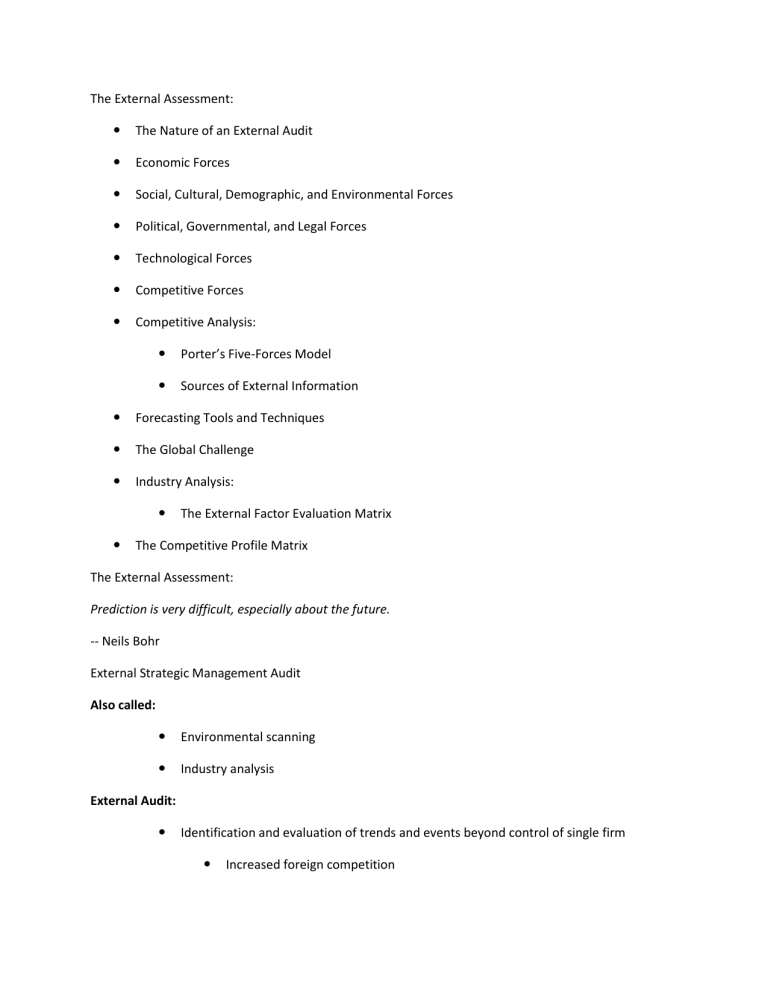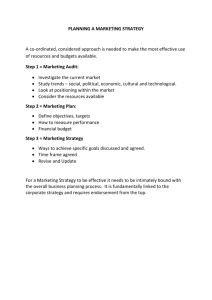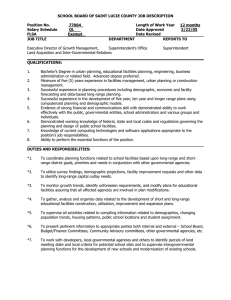lec 7

The External Assessment:
The Nature of an External Audit
Economic Forces
Social, Cultural, Demographic, and Environmental Forces
Political, Governmental, and Legal Forces
Technological Forces
Competitive Forces
Competitive Analysis:
Porter’s Five-Forces Model
Sources of External Information
Forecasting Tools and Techniques
The Global Challenge
Industry Analysis:
The External Factor Evaluation Matrix
The Competitive Profile Matrix
The External Assessment:
Prediction is very difficult, especially about the future.
-- Neils Bohr
External Strategic Management Audit
Also called:
Environmental scanning
Industry analysis
External Audit:
Identification and evaluation of trends and events beyond control of single firm
Increased foreign competition
Populations shifts
Aging society
Information technology
Computer revolution
Nature of External Audit
Purpose:
Development of Finite List:
Opportunities
Threats to be avoided
Key External Forces
Five (5) broad categories:
1.
Economic forces
2.
Social, cultural, demographic, & environmental forces
3.
Political, governmental, and legal forces
4.
Technological factors
5.
Competitive forces
Performing an External Audit:
Gather competitive intelligence on factors:
Social
Cultural
Demographic
Environmental
Economic
Political, legal, governmental
technological
Sources of information include:
Internet
Libraries (corporate, university, public)
Suppliers
Distributors
Customers
Competition
Key factors:
Vary over time
Vary by industry
Variables include:
Market share
Breadth of competing products
World economies
Foreign affiliates
Proprietary account advantages
Price competitiveness
Technological advancements
Interest rates
Pollution abatement
Key External Factors:
1.
Oriented to long-term & annual objectives
2.
Measurable
3.
Applicable to all competing firms
4.
Hierarchical
• Overall company
• Divisional or functional areas
Monitor Key Economic Variables:
Availability of credit
Level of disposable income
Interest rates
Inflation rates
Money market rates
Federal government budget deficits
Gross domestic product trend
Consumption patterns
Unemployment trends
Worker productivity levels
Value of the dollar in world markets
Stock market trends
Foreign countries’ economic conditions
Import/export factors
Demand shifts for goods/services
Income differences by region/customer
Price fluctuations
Exportation of labor & capital
Monetary policies
Fiscal policies
Tax rates
ECC policies
OPEC policies
LDC policies
Social, Cultural, Demographic & Environmental Forces
Major impact on:
Products
Services
Markets
customers
Consider:
United States—
Population growing older
Less Caucasian
Gap between rich and poor widening
65 and older will rise to 18.5% of population by 2025
By 2075, no racial or ethnic majority
World population > 6 billion
U.S. population < 300 million
Great potential for domestic production expansion to other markets
Domestic only is a risky strategy
NAFTA
U.S. exports to Mexico increased 170%
2000, U.S. trade deficits:
Mexico -- $25 billion
China -- $84 billion
Japan -- $81 billion
2001 Recession (U.S. and World)
> 60,000 laid off along Mexico Border with U.S.
Trends for the 2000’s –
More educated consumers
Population aging
Minorities more influential
Local rather than federal solutions
Fixation with youth decreasing
Hispanics increase to 15% by 2021
African Americans increase to 14% by 2021
Key variables –
Childbearing rates
Number of special-interest groups
Number of marriages
Number of divorces
Number of births
Number of deaths
Immigration & emigration rates
Monitor Key Variables
Life expectancy rates
Per capita income
Attitudes toward business
Average disposable income
Buying habits
Ethical concerns
Attitudes toward saving
Political, Govt., & Legal Forces
Government Regulation
Key opportunities & key threats
Antitrust legislation (Microsoft)
Tax rates
Lobbying efforts
Patent laws
Increasing Global Interdependence
• Impact of political variables
– Formulation of Strategies
– Implementation of Strategies










